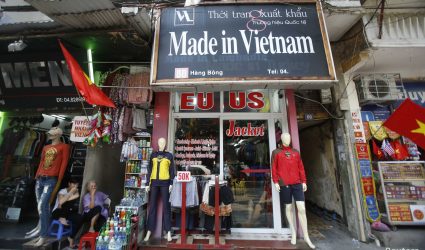China’s loss is Vietnam’s gain as clothing exports to US take a hit

(SCMP) – Seven months ago, China was still the largest supplier of products for fashion companies in the United States, but its significant advantage over Vietnam has since evaporated because of the coronavirus and the decoupling tensions between the world’s two biggest economies.
US apparel imports from China, by value, dropped from almost 30 per cent in 2019 to 20 per cent in the first half of 2020, now on par with Vietnam after the Southeast Asian nation improved its market share from 16 per cent over the same period, according to the US Department of Commerce.
The erosion of the Chinese position in the US fashion supply chain partially reflects growing tensions, as American fashion firms are forced to reduce their exposure to Chinese suppliers in response to the trade war, the coronavirus pandemic and deteriorating bilateral relations.
A survey by the United States Fashion Industry Association, which polled 25 executives from leading fashion companies in the second quarter, found that while most imported from a mixture of countries, including China and Vietnam, 29 per cent said they sourced more from Vietnam than China this year, up from 25 per cent last year.
Data released this week by the office of textiles and apparel under the US Department of Commerce showed that in terms of quantity, China still contributed at least 30 per cent of US apparel imports in the first half of the year.
But, crucially, this was at much lower prices than average, as most Chinese manufacturers and traders reduced their prices heavily to maintain overseas orders and survive weak demand.
The unit price of the US apparel imports from China dropped from US$2.25 per square metre equivalent last year to around US$1.88 in the first half of 2020, a decline of 16 per cent that was much larger than the average 3 per cent price drop of all apparel imports. Prices offered by Chinese suppliers have been around 30 per cent lower than other Asian countries this year.
As of July, around US$30 billion of US textile, apparel and home textile product imports from China, or 90 per cent of the total, were subject to a 7.5 per cent tariffs on top of normal tax duties due to the trade war.
“Should US-China trade tensions continue to escalate, it is likely that US fashion companies will substantially cut their China sourcing further, even if it is not a preferred choice economically,” said Sheng Lu, associate professor of fashion and apparel studies at the University of Delaware.
Concerns over forced labour within the clothing manufacturing industry in China’s far western Xinjiang Uygur Autonomous Region has been the latest obstacle holding back US imports of apparel and other textile goods from China.
An executive surveyed by the fashion industry association said they had “cancelled orders and shipments; shifted production away from the region completely”, while another said they had “worked with third-party auditors to ramp up audit efforts” to ensure their imports were not made with forced labour.
The worsening ties between the US and China has also accelerated the move already underway by Chinese manufacturers and exporters to shift some productions out of China to nearby countries to take advantage of lower labour costs and avoid American import tariffs. However, the shift has been slowed this year due to travel restrictions caused by the pandemic.
“Foreign investments have truly played a critical role in helping Vietnam develop and expand its garment production capacity,” added Lu from the University of Delaware.
Over the past three decades, foreign direct investment flowing into Vietnam’s textile and garment industry totalled US$19.5 billion, with South Korea being the top source, followed by Taiwan, Hong Kong and China, according to the Ministry of Planning and Investment in Vietnam.
In recent years, China has been exporting fewer finished clothes and more textile materials to other countries, where they are made into garments. In the first seven months of the year, China’s exports of textiles increased by 31 per cent, while shipments of apparel and accessories fell by 16 per cent, according to China’s General Administration of Customs.
“It is important to recognise that China is playing an increasingly critical role as a textile supplier for many apparel-exporting countries in Asia,” Lu said.
Measured by value, more than half of textile imports into other Asian countries came from China last year, compared with 37.2 per cent a decade earlier.
While US fashion firms have been reducing their reliance on Chinese productions for several years, it will remain a key base for sourcing in the near future, particularly after the coronavirus pushed many firms to cut costs dramatically.
Around 70 per cent of respondents to the fashion industry association survey expected to decrease their sourcing from China through 2022, down from 83 per cent last year.
“It is difficult for our company, and the [product] price point that it serves, to source outside of China,” one executive said. “Even with the tariffs, we cannot access the proper fabrics, prices and volumes in other regions. Other regions must develop the capacity for us to leave. Therefore, we are looking at all cost-cutting measures.”

